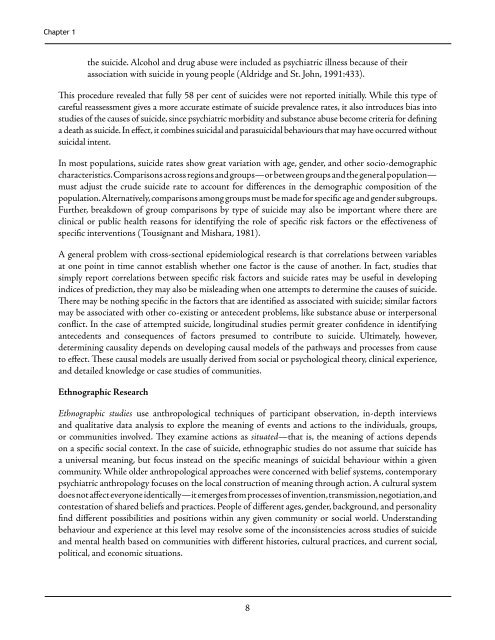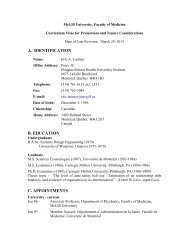Suicide Among Aboriginal People in Canada - Institut universitaire ...
Suicide Among Aboriginal People in Canada - Institut universitaire ...
Suicide Among Aboriginal People in Canada - Institut universitaire ...
You also want an ePaper? Increase the reach of your titles
YUMPU automatically turns print PDFs into web optimized ePapers that Google loves.
Chapter 1the suicide. Alcohol and drug abuse were <strong>in</strong>cluded as psychiatric illness because of theirassociation with suicide <strong>in</strong> young people (Aldridge and St. John, 1991:433).This procedure revealed that fully 58 per cent of suicides were not reported <strong>in</strong>itially. While this type ofcareful reassessment gives a more accurate estimate of suicide prevalence rates, it also <strong>in</strong>troduces bias <strong>in</strong>tostudies of the causes of suicide, s<strong>in</strong>ce psychiatric morbidity and substance abuse become criteria for def<strong>in</strong><strong>in</strong>ga death as suicide. In effect, it comb<strong>in</strong>es suicidal and parasuicidal behaviours that may have occurred withoutsuicidal <strong>in</strong>tent.In most populations, suicide rates show great variation with age, gender, and other socio-demographiccharacteristics. Comparisons across regions and groups—or between groups and the general population—must adjust the crude suicide rate to account for differences <strong>in</strong> the demographic composition of thepopulation. Alternatively, comparisons among groups must be made for specific age and gender subgroups.Further, breakdown of group comparisons by type of suicide may also be important where there arecl<strong>in</strong>ical or public health reasons for identify<strong>in</strong>g the role of specific risk factors or the effectiveness ofspecific <strong>in</strong>terventions (Tousignant and Mishara, 1981).A general problem with cross-sectional epidemiological research is that correlations between variablesat one po<strong>in</strong>t <strong>in</strong> time cannot establish whether one factor is the cause of another. In fact, studies thatsimply report correlations between specific risk factors and suicide rates may be useful <strong>in</strong> develop<strong>in</strong>g<strong>in</strong>dices of prediction, they may also be mislead<strong>in</strong>g when one attempts to determ<strong>in</strong>e the causes of suicide.There may be noth<strong>in</strong>g specific <strong>in</strong> the factors that are identified as associated with suicide; similar factorsmay be associated with other co-exist<strong>in</strong>g or antecedent problems, like substance abuse or <strong>in</strong>terpersonalconflict. In the case of attempted suicide, longitud<strong>in</strong>al studies permit greater confidence <strong>in</strong> identify<strong>in</strong>gantecedents and consequences of factors presumed to contribute to suicide. Ultimately, however,determ<strong>in</strong><strong>in</strong>g causality depends on develop<strong>in</strong>g causal models of the pathways and processes from causeto effect. These causal models are usually derived from social or psychological theory, cl<strong>in</strong>ical experience,and detailed knowledge or case studies of communities.Ethnographic ResearchEthnographic studies use anthropological techniques of participant observation, <strong>in</strong>-depth <strong>in</strong>terviewsand qualitative data analysis to explore the mean<strong>in</strong>g of events and actions to the <strong>in</strong>dividuals, groups,or communities <strong>in</strong>volved. They exam<strong>in</strong>e actions as situated—that is, the mean<strong>in</strong>g of actions dependson a specific social context. In the case of suicide, ethnographic studies do not assume that suicide hasa universal mean<strong>in</strong>g, but focus <strong>in</strong>stead on the specific mean<strong>in</strong>gs of suicidal behaviour with<strong>in</strong> a givencommunity. While older anthropological approaches were concerned with belief systems, contemporarypsychiatric anthropology focuses on the local construction of mean<strong>in</strong>g through action. A cultural systemdoes not affect everyone identically—it emerges from processes of <strong>in</strong>vention, transmission, negotiation, andcontestation of shared beliefs and practices. <strong>People</strong> of different ages, gender, background, and personalityf<strong>in</strong>d different possibilities and positions with<strong>in</strong> any given community or social world. Understand<strong>in</strong>gbehaviour and experience at this level may resolve some of the <strong>in</strong>consistencies across studies of suicideand mental health based on communities with different histories, cultural practices, and current social,political, and economic situations.
















